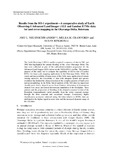Please use this identifier to cite or link to this item:
http://hdl.handle.net/10311/169Full metadata record
| DC Field | Value | Language |
|---|---|---|
| dc.contributor.author | Neuenschwander, A.L. | |
| dc.contributor.author | Crawford, M.M. | |
| dc.contributor.author | Ringrose, S. | |
| dc.date.accessioned | 2008-07-24T11:26:04Z | |
| dc.date.available | 2008-07-24T11:26:04Z | |
| dc.date.issued | 2005-10 | |
| dc.identifier.citation | Neuenschwander, A.L. et al (2005) Results from the EO-1 experiment - A comparative study of Earth Observing-1 Advanced Land Imager (ALI) and Landsat ETM+ data for land cover mapping in the Okavango Delta, Botswana, International Journal of Remote Sensing Vol. 26, No. 19, October, pp. 4321-4337 | en |
| dc.identifier.issn | 0143-1161 [print] | |
| dc.identifier.issn | 1366-5901 [online] | |
| dc.identifier.uri | http://hdl.handle.net/10311/169 | |
| dc.description.abstract | The Earth Observing-1 (EO-1) satellite acquired a sequence of data in 2001 and 2002 that highlighted the annual flooding of the lower Okavango Delta. The data were collected as part of the calibration/validation programme for the Advanced Land Imager (ALI) sensor on the NASA EO-1 satellite. The primary purpose of this study was to compare the capability of ALI to that of Landsat ETM+ for large-scale mapping applications in the Okavango Delta. While the extent and inaccessibility of many areas of the Delta make application of remote sensing attractive, the availability of data with adequate spatial and spectral resolution has limited the characterization of the complex patterns of land cover and geomorphology in the Delta. Initial analysis of the ALI data via supervised classification clearly showed macro-flood features, delineation of downstream channel flow areas, and lateral-downstream inundation of the floodplain. These patterns and the proportions of flooding of the channel compared to that of the floodplain (impoundment) varied annually, from the wetter seasonal swamps through the drier seasonal and occasional swamps. Consistently higher classification accuracies achieved using ALI data relative to ETM+ data are attributed to the higher signal-to-noise ratio and the increased dynamic range of the ALI data. | en |
| dc.description.sponsorship | This research was supported in part by the National Aeronautics and Space Administration EO-1 program (NCC5-463) and the Army Research Office Terrestrial Sciences Program (DAAG55-98-1-0287) | en |
| dc.language.iso | en | en |
| dc.publisher | Taylor & Francis; http://www.tandf.co.uk/journals/titles/01431161.asp | en |
| dc.subject | Okavango Delta | en |
| dc.subject | Advanced Land Imager (ALI) Sensor | en |
| dc.subject | Flooding | en |
| dc.title | Results from the EO-1 experiment - A comparative study of Earth Observing-1 Advanced Land Imager (ALI) and Landsat ETM+ data for land cover mapping in the Okavango Delta, Botswana | en |
| dc.type | Article | en |
| Appears in Collections: | Research articles (ORI) | |
Files in This Item:
| File | Description | Size | Format | |
|---|---|---|---|---|
| neuenschwander_ringrose_ijrs_2005.pdf | 2.24 MB | Adobe PDF |  View/Open | |
| license.txt | 1.95 kB | Text | View/Open |
Items in DSpace are protected by copyright, with all rights reserved, unless otherwise indicated.
